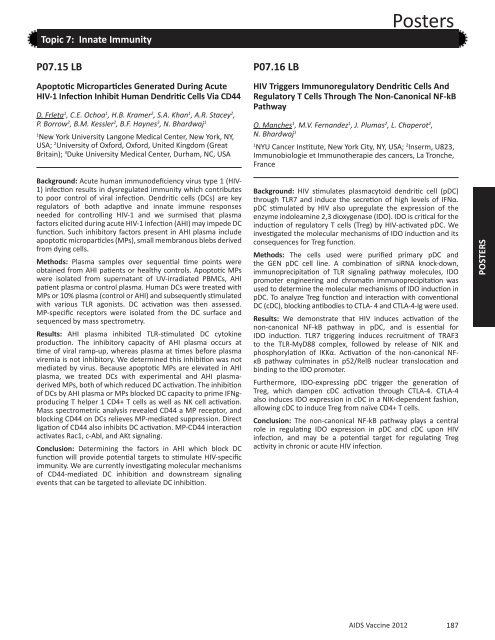Oral Abstract Session 01 - Global HIV Vaccine Enterprise
Oral Abstract Session 01 - Global HIV Vaccine Enterprise
Oral Abstract Session 01 - Global HIV Vaccine Enterprise
Create successful ePaper yourself
Turn your PDF publications into a flip-book with our unique Google optimized e-Paper software.
Topic 7: Innate Immunity<br />
P07.15 LB<br />
Apoptotic Microparticles Generated During Acute<br />
<strong>HIV</strong>-1 Infection Inhibit Human Dendritic Cells Via CD44<br />
D. Frleta 1 , C.E. Ochoa 1 , H.B. Kramer 2 , S.A. Khan 1 , A.R. Stacey 2 ,<br />
P. Borrow 2 , B.M. Kessler 2 , B.F. Haynes 3 , N. Bhardwaj 1<br />
1 New York University Langone Medical Center, New York, NY,<br />
USA; 2 University of Oxford, Oxford, United Kingdom (Great<br />
Britain); 3 Duke University Medical Center, Durham, NC, USA<br />
Background: Acute human immunodeficiency virus type 1 (<strong>HIV</strong>-<br />
1) infection results in dysregulated immunity which contributes<br />
to poor control of viral infection. Dendritic cells (DCs) are key<br />
regulators of both adaptive and innate immune responses<br />
needed for controlling <strong>HIV</strong>-1 and we surmised that plasma<br />
factors elicited during acute <strong>HIV</strong>-1 infection (AHI) may impede DC<br />
function. Such inhibitory factors present in AHI plasma include<br />
apoptotic microparticles (MPs), small membranous blebs derived<br />
from dying cells.<br />
Methods: Plasma samples over sequential time points were<br />
obtained from AHI patients or healthy controls. Apoptotic MPs<br />
were isolated from supernatant of UV-irradiated PBMCs, AHI<br />
patient plasma or control plasma. Human DCs were treated with<br />
MPs or 10% plasma (control or AHI) and subsequently stimulated<br />
with various TLR agonists. DC activation was then assessed.<br />
MP-specific receptors were isolated from the DC surface and<br />
sequenced by mass spectrometry.<br />
Results: AHI plasma inhibited TLR-stimulated DC cytokine<br />
production. The inhibitory capacity of AHI plasma occurs at<br />
time of viral ramp-up, whereas plasma at times before plasma<br />
viremia is not inhibitory. We determined this inhibition was not<br />
mediated by virus. Because apoptotic MPs are elevated in AHI<br />
plasma, we treated DCs with experimental and AHI plasmaderived<br />
MPs, both of which reduced DC activation. The inhibition<br />
of DCs by AHI plasma or MPs blocked DC capacity to prime IFNgproducing<br />
T helper 1 CD4+ T cells as well as NK cell activation.<br />
Mass spectrometric analysis revealed CD44 a MP receptor, and<br />
blocking CD44 on DCs relieves MP-mediated suppression. Direct<br />
ligation of CD44 also inhibits DC activation. MP-CD44 interaction<br />
activates Rac1, c-Abl, and AKt signaling.<br />
Conclusion: Determining the factors in AHI which block DC<br />
function will provide potential targets to stimulate <strong>HIV</strong>-specific<br />
immunity. We are currently investigating molecular mechanisms<br />
of CD44-mediated DC inhibition and downstream signaling<br />
events that can be targeted to alleviate DC inhibition.<br />
P07.16 LB<br />
AIDS <strong>Vaccine</strong> 2<strong>01</strong>2<br />
Posters<br />
<strong>HIV</strong> Triggers Immunoregulatory Dendritic Cells And<br />
Regulatory T Cells Through The Non-Canonical NF-kB<br />
Pathway<br />
O. Manches 1 , M.V. Fernandez 1 , J. Plumas 2 , L. Chaperot 2 ,<br />
N. Bhardwaj 1<br />
1 NYU Cancer Institute, New York City, NY, USA; 2 Inserm, U823,<br />
Immunobiologie et Immunotherapie des cancers, La Tronche,<br />
France<br />
Background: <strong>HIV</strong> stimulates plasmacytoid dendritic cell (pDC)<br />
through TLR7 and induce the secretion of high levels of IFNα.<br />
pDC stimulated by <strong>HIV</strong> also upregulate the expression of the<br />
enzyme indoleamine 2,3 dioxygenase (IDO). IDO is critical for the<br />
induction of regulatory T cells (Treg) by <strong>HIV</strong>-activated pDC. We<br />
investigated the molecular mechanisms of IDO induction and its<br />
consequences for Treg function.<br />
Methods: The cells used were purified primary pDC and<br />
the GEN pDC cell line. A combination of siRNA knock-down,<br />
immunoprecipitation of TLR signaling pathway molecules, IDO<br />
promoter engineering and chromatin immunoprecipitation was<br />
used to determine the molecular mechanisms of IDO induction in<br />
pDC. To analyze Treg function and interaction with conventional<br />
DC (cDC), blocking antibodies to CTLA- 4 and CTLA-4-Ig were used.<br />
Results: We demonstrate that <strong>HIV</strong> induces activation of the<br />
non-canonical NF-kB pathway in pDC, and is essential for<br />
IDO induction. TLR7 triggering induces recruitment of TRAF3<br />
to the TLR-MyD88 complex, followed by release of NIK and<br />
phosphorylation of IKKα. Activation of the non-canonical NFκB<br />
pathway culminates in p52/RelB nuclear translocation and<br />
binding to the IDO promoter.<br />
Furthermore, IDO-expressing pDC trigger the generation of<br />
Treg, which dampen cDC activation through CTLA-4. CTLA-4<br />
also induces IDO expression in cDC in a NIK-dependent fashion,<br />
allowing cDC to induce Treg from naïve CD4+ T cells.<br />
Conclusion: The non-canonical NF-kB pathway plays a central<br />
role in regulating IDO expression in pDC and cDC upon <strong>HIV</strong><br />
infection, and may be a potential target for regulating Treg<br />
activity in chronic or acute <strong>HIV</strong> infection.<br />
187<br />
POSTERS


